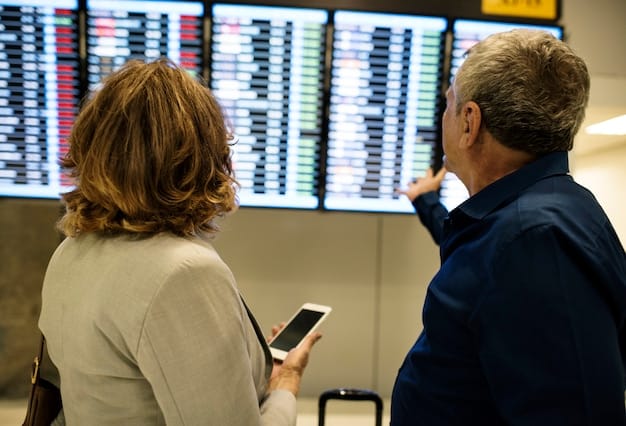Decoding Airline Change Fees: Your Guide to Savings in 2025

Decoding Airline Change Fees: How to Avoid Paying Extra in 2025 involves understanding airline policies, leveraging travel insurance, utilizing airline waivers, and considering flexible booking options to minimize or eliminate potential change fees.
Navigating the world of airline change fees can feel like deciphering a complex code. This guide, “Decoding Airline Change Fees: How to Avoid Paying Extra in 2025,” provides practical strategies to help you save money and travel smarter.
Understanding the Basics of Airline Change Fees
Airline change fees are charges levied by airlines when passengers need to modify their flight itineraries after booking. These fees can vary widely depending on the airline, the type of ticket purchased, and the timing of the change. Understanding these basics is the first step in avoiding unexpected costs.
Change fees exist for several reasons, primarily to manage seat inventory and discourage speculative bookings. Airlines use complex pricing models, and change fees help offset potential revenue losses from passengers altering their flights after initial pricing has been set.
Why Do Airlines Charge Change Fees?
Airlines impose change fees as part of their revenue management strategy. By charging these fees, they aim to optimize seat occupancy and maximize profits. This practice also helps airlines to cover the administrative costs associated with processing changes to flight bookings.
Factors Influencing Change Fee Amounts
Several factors can influence the amount of an airline change fee. These include the fare class of the ticket (basic economy tickets often have the highest fees or are non-changeable), the airline’s specific policies, and the difference in fare between the original and new flights.
- Fare Class: Lower fare classes typically have stricter rules and higher change fees.
- Airline Policy: Each airline has its own specific change fee policies, which can vary significantly.
- Time of Change: Changes made closer to the departure date usually incur higher fees.
In conclusion, understanding why airlines charge change fees and the factors that influence these fees can empower travelers to make informed decisions when booking flights. By being aware of these basics, you can better navigate airline policies and minimize the risk of incurring unexpected charges when changes become necessary.

Navigating Airline Change Fee Policies in 2025
To effectively navigate airline change fee policies in 2025, it’s essential to stay informed about the latest regulations and practices. Many airlines have revised their change fee policies due to evolving market conditions and customer expectations. Staying up-to-date can save you significant money and stress.
Airline change fee policies can vary significantly, not only between different airlines but also within the same airline, depending on the type of ticket purchased. Understanding these distinctions is critical for making informed travel decisions.
Key Changes in Airline Policies in 2025
In 2025, several key changes in airline policies regarding change fees have emerged. Some airlines have permanently eliminated change fees for certain fare classes, while others have maintained or adjusted their fees based on market demand and operational needs. Keep abreast of these changes by regularly checking airline websites and travel news sources.
Comparing Change Fee Policies Across Major US Airlines
Major US airlines often have distinct change fee policies. Comparing these policies can help travelers choose airlines that offer more flexibility and lower fees. For instance, some airlines might waive change fees for certain types of tickets or for changes made within a specific timeframe prior to departure.
- Delta Airlines: Generally does not charge change fees for most tickets.
- United Airlines: Similar to Delta, often waives change fees for many fare types.
- American Airlines: Usually aligns with Delta and United in waiving change fees for standard tickets.
Staying informed about the evolving landscape of airline change fee policies is essential for any traveler looking to minimize costs and maximize flexibility. By understanding the nuances of these policies, you can make smarter booking decisions and avoid unnecessary charges when your travel plans change.
Leveraging Travel Insurance to Cover Change Fees
Travel insurance can be a valuable tool for mitigating the financial impact of airline change fees. These policies often include provisions that cover change or cancellation fees due to unforeseen circumstances. Understanding how to leverage travel insurance can provide significant peace of mind and financial protection.
Travel insurance policies typically cover a range of unexpected events that may necessitate changes to your travel plans. These events can include illness, injury, family emergencies, and certain types of travel advisories.
How Travel Insurance Policies Can Help
Travel insurance policies can help cover change fees by reimbursing you for the costs incurred when you need to alter your flight itinerary due to a covered event. The extent of coverage depends on the specific policy and its terms, so it’s essential to review the details carefully.
Tips for Choosing the Right Travel Insurance
Choosing the right travel insurance policy involves considering several factors, including the coverage limits, the types of events covered, and any exclusions or limitations. Here are some tips to help you select the best policy for your needs:
- Review Coverage Limits: Ensure the policy provides adequate coverage for change fees and other potential travel expenses.
- Check Covered Events: Verify that the policy covers the types of events that are most likely to affect your travel plans.
- Understand Exclusions: Be aware of any exclusions or limitations in the policy, such as pre-existing medical conditions or specific travel advisories.
In summary, travel insurance can be an effective way to protect yourself from incurring significant airline change fees. By understanding the coverage options and choosing the right policy, you can travel with confidence knowing that you have financial protection in case of unforeseen circumstances.
Utilizing Airline Waivers and Exceptions
Airline waivers and exceptions can provide opportunities to avoid change fees under specific circumstances. Airlines may offer waivers during events like severe weather, natural disasters, or significant disruptions. Understanding how to take advantage of these waivers can help you avoid paying extra when your travel plans are affected.
Airlines sometimes issue waivers in response to events that disrupt travel. These waivers typically allow passengers to change their flights without incurring the standard change fees.
When Airlines Typically Offer Waivers
Airlines typically offer waivers during major disruptions such as:
- Severe Weather: Hurricanes, blizzards, and other extreme weather events.
- Natural Disasters: Earthquakes, wildfires, and floods.
- Significant Disruptions: Airport closures, air traffic control issues, and strikes.
To take advantage of airline waivers, monitor airline announcements and check their websites regularly for updates. When a waiver is issued, follow the instructions provided by the airline to change your flight without incurring fees.
Strategies for Requesting a Waiver
While airlines may not always publicize waivers, there are strategies you can use to request one in certain situations. These strategies involve communicating with the airline and presenting your case effectively.
If you encounter a situation that you believe warrants a waiver, contact the airline’s customer service department. Explain your situation clearly and politely, and ask if a waiver can be applied. Be prepared to provide documentation or evidence to support your request.
In conclusion, staying informed about airline waivers and knowing how to request one can be a valuable asset when travel disruptions occur. By monitoring airline communications and being proactive in seeking waivers, you can minimize the financial impact of unexpected changes to your travel plans.

Considering Flexible Booking Options
Flexible booking options are designed to provide travelers with more control over their itineraries, often allowing changes without incurring fees. By understanding and using these options, you can enjoy greater peace of mind and avoid unexpected costs when your travel plans evolve.
Flexible booking options come in various forms, including changeable tickets, subscription programs, and flexible date searches. Each option offers unique benefits and can be tailored to different travel needs.
Understanding Changeable Tickets and Subscriptions
Changeable tickets typically allow you to modify your flight dates or times without paying a change fee. These tickets often come with a slightly higher initial price, but the added flexibility can be worth it if you anticipate potential changes to your itinerary. Airline subscriptions sometimes offer perks that include fee waivers.
Using Flexible Date Searches
Flexible date searches are tools offered by airlines and online travel agencies that allow you to view fares for a range of dates. By using these tools, you can identify the cheapest days to fly and adjust your itinerary accordingly, potentially avoiding change fees altogether. For example, tools on GoogleFlights.
- Identify Cheapest Dates: Use flexible date searches to find the lowest fares.
- Compare Prices: Evaluate the cost of different dates to see if shifting your travel plans can save money.
- Adjust Itinerary: Consider alternative dates to avoid change fees and reduce overall travel costs.
In summary, flexible booking options provide travelers with valuable tools for managing their travel plans and avoiding change fees. By understanding and using these options, you can enjoy greater control over your travel experience and protect yourself from unexpected costs when changes become necessary.
Loyalty Programs and Credit Card Perks
Airline loyalty programs and travel credit cards can offer a range of benefits that help you avoid airline change fees. By leveraging these programs, you can gain access to perks and privileges that provide greater flexibility and cost savings.
Loyalty programs reward frequent flyers with points or miles that can be redeemed for various benefits. Many programs offer elite status levels that come with valuable perks, such as waived change fees or discounted fares. Travel credit cards often provide similar benefits, either through direct waivers or reimbursement programs.
Earning Status and Benefits
Earning elite status in an airline loyalty program typically requires accumulating a certain number of miles or points within a specified period. As you climb the tiers of elite status, you unlock additional benefits, such as priority boarding, lounge access, and waived change fees.
Credit Cards with Travel Perks
Many travel credit cards offer perks that can help you avoid airline change fees. These perks may include:
- Change Fee Waivers: Some cards directly waive change fees for cardholders.
- Travel Credits: Cards may offer annual travel credits that can be used to offset change fees.
- Travel Insurance: Certain cards provide travel insurance that covers change fees in specific situations.
By strategically using airline loyalty programs and travel credit cards, you can unlock a range of benefits that help you avoid airline change fees. These programs can provide valuable cost savings and enhance your overall travel experience by offering greater flexibility and convenience.
| Key Point | Brief Description |
|---|---|
| 💰 Understand Policies | Know the change fee policies of different airlines to make informed choices. |
| 🛡️ Travel Insurance | Use travel insurance to cover fees from unexpected changes. |
| 🎫 Airline Waivers | Take advantage of airline waivers during disruptions. |
| ✈️ Flexible Bookings | Opt for flexible bookings to avoid hefty change fees. |
Frequently Asked Questions
▼
Airlines charge change fees primarily to manage seat inventory, discourage speculative bookings, and offset administrative costs associated with processing changes to flight itineraries efficiently.
▼
Travel insurance policies can cover change fees by reimbursing costs when changes are due to covered unexpected events like illness or family emergencies, as laid out in the policy terms.
▼
Airlines usually offer waivers during significant travel disruptions, such as severe weather, natural disasters, or major airport closures, allowing passengers to change flights without the usual fees.
▼
Flexible booking options are services from airlines that offer travelers the ability to modify or change their flight dates or times without incurring standard change fees, providing greater control and peace of mind.
▼
Airline loyalty programs can help by offering elite status perks like waived change fees or discounted fares to frequent flyers, as well as benefits through associated travel credit cards that may waive fees or offer travel credits.
Conclusion
By understanding airline change fee policies, leveraging travel insurance, utilizing airline waivers, considering flexible booking options, and maximizing loyalty programs, you can navigate the complexities of air travel in 2025 and significantly reduce or eliminate the risk of paying extra. Staying informed and proactive is the key to saving money and enjoying stress-free travel.





